At Your Boxes:
Books, videos, CDs, and the web all help if you want to learn about wild birds. But at some point you need to get out and see your subjects first hand. And now is your chance. Your first Tree Swallow has made its spring return! Photo below by Danny Bales.
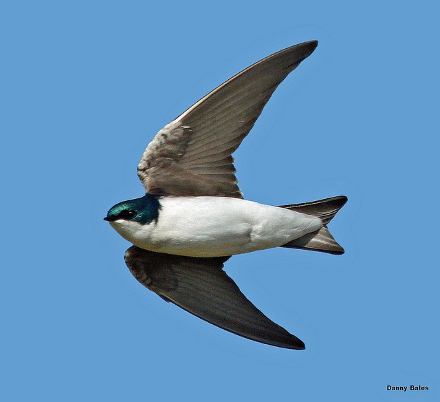
It’s early spring. Temperatures drop below freezing sometimes, but in spite of this Tree Swallows have begun the migration north. And as they reached their breeding range and spread out some have discovered the nest boxes you put up for them.
So now it’s time to start getting to know your birds.
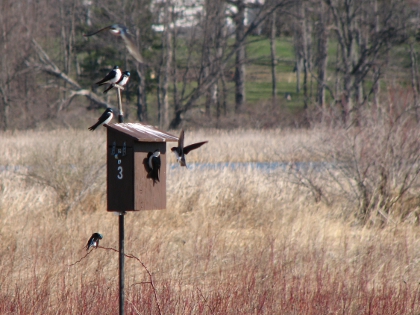
Put on warm clothes, boots, hat and gloves, since there may still be snow on the ground (see below). Bring an old folding chair, (but if the ground is soft you’ll end up standing). Binocs help if this is your first real meeting with Tree Swallows. Later in the season you probably won’t need them.

Go in the morning when a Tree Swallow on its spring return is most apt to visit and explore potential nest sites. Early season afternoons they usually spend elsewhere feeding rather than prospecting for nest sites.
Sit where you can watch boxes with swallow activity. The swallows’ behavior centers on the boxes because these boxes and their contents will be the most important things in the swallows’ lives for the next ten weeks. Watch for awhile, then move to another box and watch some more. And as you observe ask yourself why in the world these birds have arrived so early in the year.
Concepts:
Where do Tree Swallows spend the winter months?
- Many Tree Swallows winter in warm parts of the southern U.S., especially in Florida and Louisiana.
- Others winter even farther south in Mexico, Central America and Cuba.
- Tree Swallow winter range is shown in yellow, below.
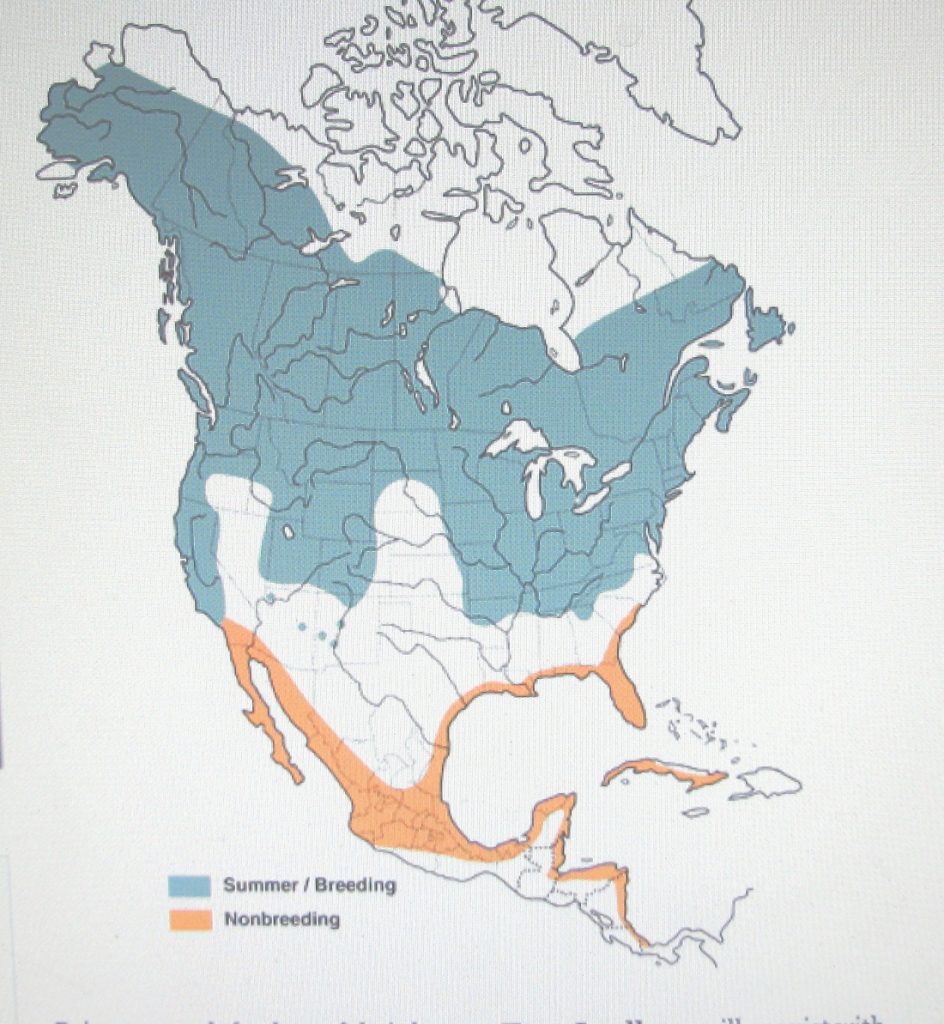
What’s the advantage of wintering in the south for Tree Swallows?
- A Tree Swallow’s primary food is flying insects.
- Flying insects are usually unavailable during northern winters, so Tree Swallows concentrate at buggy southern wetlands in winter, sometimes in huge flocks.
- Unfortunately, many wetlands on the wintering grounds have been lost or degraded by development, agriculture and aquaculture.
- Tree Swallows also eat certain types of berries on their southward migration and especially in winter, and these particular berries aren’t found at most of the swallows’ northern nesting grounds.
When is the Tree Swallow spring return where you live?
- This depends on several things, including how far you are from the swallows’ wintering grounds, the swallows’ migration path, the general climate in your area, and the weather conditions you happen to be experiencing this particular year.
- You can usually get regional arrival information by asking birding experts in your area, or you can refer to eBird, the world’s largest wildlife database, as follows:
- On the eBird website choose the Explore page.
- From the Explore page select Bar Charts, which takes you to the Choose Locations page.
- On the Choose Locations page, identify your Region (country and state or province), and then your Subregion (choose one or more counties). Then select Continue.
- Next, a Bird Observations page will appear. Scroll down the species list and select Tree Swallow.
- The Tree Swallow observations page will appear, with graphs showing its occurrence and frequency at the location you’ve chosen.
- There are two partial examples below.
- The first shows that Tree Swallows are arriving in the Danville, Virginia, area by Mid-March.

- In contrast, the second reveals that this species usually doesn’t arrive much before early May in Prince Albert, Saskatchewan.

- If you’re interested in the annual continent-wide movements of the Tree Swallow as a species eBird now offers an excellent “Abundance Animation” video.
Why does a Tree Swallow make a spring return to the breeding grounds so early? Isn’t this dangerous? After all, the north isn’t very buggy in early spring.
- The swallows return early, risking death from starvation and hypothermia. They do this for one reason, to try to get nest sites so they can have a chance to reproduce.
- The next 80-90 days of their lives will center on nest sites and their contents.
- Tree Swallows unlucky enough to be caught by early-spring cold weather find themselves in a struggle for their lives.
- Photo below by Rich Rehrig.
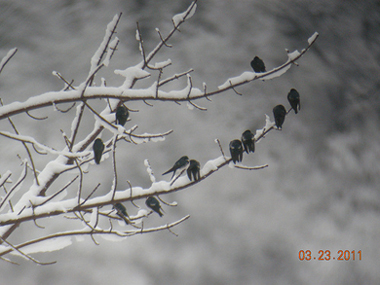
- Note how the desperate swallows in Colin Haigh’s photo below have huddled together to conserve body heat. Some have actually perched on the backs of others! They have also fluffed up their feathers to trap more air underneath, which increases their insulation value.
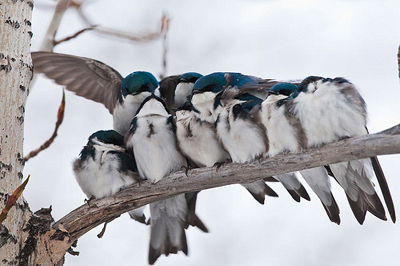
- Click here for a sobering YouTube video by Ken Cheatham showing Tree Swallows and Violet-Green Swallows desperately trying to survive a spring cold snap in Alaska by huddling together.
- Another form of huddling to conserve heat is “communal roosting,” in which a group of birds crowds into a cavity or nest box overnight.
- The feces on the floor below were accumulated on a single night, evidence that Tree Swallows used the box as a communal roost.
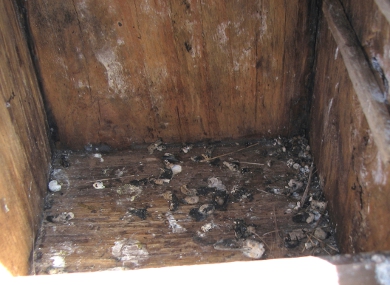
- Huddling and communal roosting behavior probably save the lives of many Tree Swallows each year, but in spite of these efforts birds weakened by days with little heat or food may die.
- Be warned: After cold snaps you may find dead adult Tree Swallows inside your boxes. The seven barely recognizable swallows below all died in a single box.
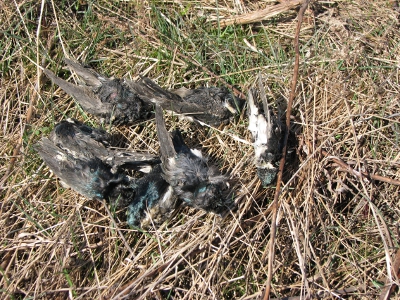
But hopefully your Tree Swallows arrived to find good weather and aren’t struggling to survive.
And if you’re new to this species, spring return is a good time to check out the basic Tree Swallow appearance:
- Slender, streamlined, bullet-shaped body.
- Dark head and upper body that’s usually, but not always, iridescent blue-green.
- Pure white throat and under-body.
- Wings long, dark and pointed.
- Tail short, dark and notched.
- Head somewhat flattish with short neck.
- Eyes dark and hard to see.
- Bill short and small.
- Feet small and legs very short.
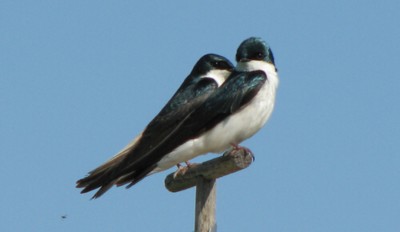
There’s a saying that “form follows function.” So what do you think Tree Swallow bodies are specialized for?
How do they fly?
- Fast or slow?
- Agile or awkward?
- Turn a lot or fly in straight lines?
How do they move on the ground?
- Walk or hop?
- Move easily or awkwardly?
- Did you even see one on the ground?
Are Tree Swallows specialized for life in the air or on the ground? Where do you think they find most of their food?
- Tree Swallows are extremely skilled, highly-maneuverable fliers that spend many hours in the air every day.
- Books often mention their tendency to glide in circles, but like all other North American swallows they can also soar, kite, hover, power dive, dash, or flutter slowly, as the situation demands.
- Tree Swallows feed by catching flying insects in their mouths.
- They may land on the ground to sun, shelter from high wind and cold, get nest material, or find certain foods, but they usually perch above-ground.
Why do the swallows let you watch them so closely?
- They are such good fliers they know escape from you is easy.
- They may not view you as something dangerous at all.
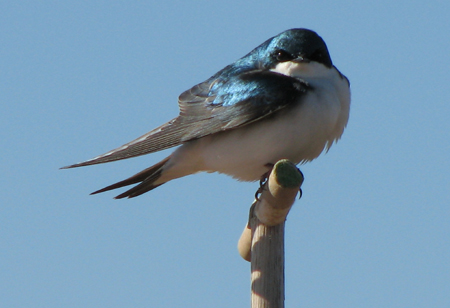
Seeing your arriving Tree Swallows’ behavior up close lets you start perfecting your observation skills. As you watch them, ask yourself:
- What’s each behavior’s purpose? How does it help Tree Swallows survive or raise young?
- What stimulates a behavior, causing it to occur?
- Does a particular behavior’s frequency change during the nesting season, and if so, why?
- Do males and females behave alike or differently, and why?
Question for the next Topic: Tree Swallow Behaviors shown in the Nesting Season.
- What are some characteristics of songbird behavior?
————————————————————————-
Home: Tree Swallow Nest Box Projects
Creating Tree Swallow Nest Box Projects
Spring Return
Nesting Season Behavior
Song and Calls
Nest Site Claiming
Pair Formation
Nest Building
Bird Flight
Mating and Paternity
Diary of One Season at Salmon Creek
Monitoring Nest Boxes and Keeping Records
Making Box Checks Keeping Box Records Control Sheets Season Summaries Print Sheets
Banding Your Tree Swallows Banding Adults Banding Nestlings
Tree Swallows in Research Research Bibliography Glossary of Terms